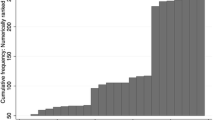Abstract
Previous research has concluded that an institution's ranking in the annual U.S. News and World Report “Best Colleges” issue impacts admission outcomes and pricing decisions at schools in the Consortium for Financing Higher Education. This article expands on the previous work by analyzing the effects of the U.S. News and World Report rankings across a broader range of universities and variables. The results show that many schools' admission outcomes are responsive to movements in the rankings; however changes in rank are more significant at certain locations in the rankings and affect public and private schools differently. The results also show that the socioeconomic and racial demographics of highly ranked universities may also be affected by changes in rank.
Similar content being viewed by others
REFERENCES
Avory, C., Fairbanks, A., and Zeckhauser, R. (2001). What worms for the early bird: Early admission at elite colleges. KSG Working Paper No. RWP01–049. Harvard University Kennedy School of Government Faculty Research Working Paper Series, Cambridge, MA.
Carmody, D. (1987, November 25). Colleges' SAT lists can be creative works. New York Times, p. E10.
Ehrenberg, D. G. (2000). Tuition Rising: Why College Costs so Much, Harvard University Press, Boston.
Eide, E., Brewer, D. J., and Ehrenberg, D. G. (1998). Does it pay to attend an elite private college? Evidence on the effects of undergraduate college quality on graduate school attendance. Economics of Education Review 17(4): 371–376.
Guinier, L., and Strum, S. (2001). Who's Qualified?, Beacon Press, Boston.
Hossler, D., and Foley, E. M. (1995). Reducing the noise in the college choice process: The use of college guidebooks and ratings. In: Walleri, R. D., and Moss, M. K. (eds.), New Directions for Institutional Research No. 88: Evaluating and Responding to College Guidebooks and Rankings, Jossey-Bass, San Francisco, pp. 21–30.
Hunter, B. (1995). College guidebooks: Background and development. In: Walleri, R. D., and Moss, M. K. (eds.), New Directions for Institutional Research No. 88: Evaluating and Responding to College Guidebooks and Rankings, Jossey-Bass, San Francisco, pp. 5–12.
Levinson, A. (2002, February 26). Early admission to college is popular, but who benefits is under debate. Detroit News, p. A5.
Litten, L. H., and Hall, A. E. (1989). In the eyes of our beholders: Some evidence on how high school students and their parents view quality in colleges. Journal of Higher Education 60(3): 302–324.
McDonough, P. M., Antonio, A, L., Walpole, M. B., and Perez, L. X. (1998). College rankings: Democratized college knowledge for whom? Research in Higher Education 39(5): 513–537.
McGuire, M. D. (1995). Validity issues for reputational studies. In: Walleri, R. D., and Moss, M. K. (eds.), New Directions for Institutional Research No. 88: Evaluating and Responding to College Guidebooks and Rankings, Jossey-Bass, San Francisco, pp. 45–59.
Monks, J., and Ehrenberg, R. G. (1999). The impact of the US News and World Report college rankings on admission outcomes and pricing policies at selective private institutions. NBER Working Paper No. 7227, National Bureau of Economic Research., Cambridge, MA.
Nettles, M. T., Thoeny, A. R., and Gosman, E. J. (1986). Comparative and predictive analysis of black and white students' college achievement and experiences. Journal of Higher Education 57(3): 289–318.
Schmitz, C. C. (1993). Assessing the validity of higher education indicators. Journal of Higher Education 64(5): 503–521.
Stecklow, S. (1995, April 5). Cheat sheets: How colleges inflate ratings. Wall Street Journal, pp. A1, A8.
Stuart, D. L. (1995). Reputational rankings: Background and development. In: Walleri, R. D., and Moss, M. K. (eds.), New Directions for Institutional Research No. 88: Evaluating and Responding to College Guidebooks and Rankings, Jossey-Bass, San Francisco, pp. 13–20.
Toma, J. D., and Cross, M. E. (1998). Intercollegiate athletics and student college choice: Exploring the impact of championship seasons on undergraduate applications. Research in Higher Education 39(6): 633–661.
Webster, D. S. (1992). Reputational rankings of colleges, universities, and individual disciplines and fields of study, from their beginnings to the present. In: Smart, J. C. (ed.), Higher Education: Handbook of Theory and Research (Vol. 8), Agathon Press, New York, pp. 234–304.
Author information
Authors and Affiliations
Corresponding author
Rights and permissions
About this article
Cite this article
Meredith, M. Why Do Universities Compete in the Ratings Game? An Empirical Analysis of the Effects of the U.S. News and World Report College Rankings. Research in Higher Education 45, 443–461 (2004). https://doi.org/10.1023/B:RIHE.0000032324.46716.f4
Issue Date:
DOI: https://doi.org/10.1023/B:RIHE.0000032324.46716.f4



